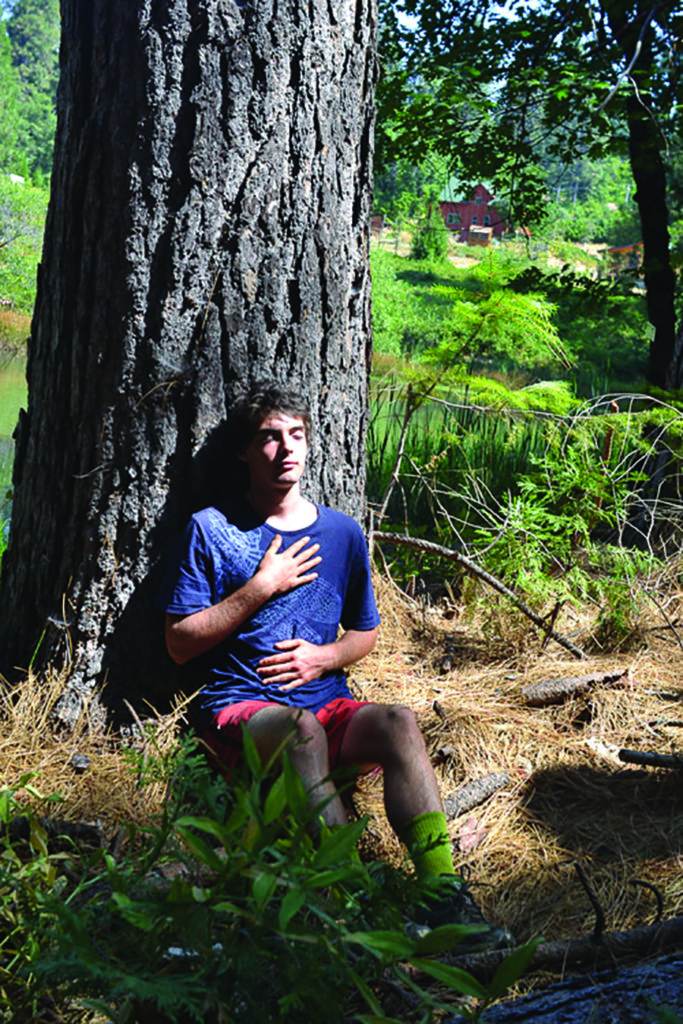A New Vision for 21st
Century Education
BY SUSAN BAUER
Embodiment—how we live in our bodies and express ourselves—is different for everyone. It evolves over our lifetime in relation to changes in our inner and outer environment. This process is never more precarious than during our teenage years.
Teens face so many challenges: changes in their brain chemistry and hormones, as well as pressures at school, at home, and from their peers. They struggle with complex lifestyle decisions regarding diet, sleep, exercise, sex, drugs, alcohol, and relationships. Increasingly, social media is both a distraction and a way of life for teenagers, affecting their self-image and self-esteem. They also must deal with the rise of disturbing issues plaguing our schools, such as bullying, teen suicide, and incidents of school violence. And while nature can be a soothing balm in our otherwise hectic lives, many teens as well as adults have become alarmingly disconnected from the natural world—and have in many ways lost touch with their inner and outer resources. All of these factors contribute to the pressing need to help adolescents successfully manage one of the most complicated and potentially empowering stages of life.
What resources do teens have to navigate these many volatile physical, emotional, and psychological challenges? Most Americans have at least 12 years or more of formal education, with an emphasis on intellectual development. While strong academics are important, the focus on cognitive function perpetuates the body-mind split so detrimental to our well-being. Learning about our bodies as well as cultivating the capacity to be fully present—attentive and responsive to our inner and outer worlds—can positively influence all aspects of our lives. Yet sadly, like many adults, teens often know more about their cell phones than they do about their own bodies.

Ironically teens are often intensely focused on their bodies, but in unhealthy ways. They obsess about their appearance, weight, athletic skills, and especially the perceptions of their peers. With so much focus on their bodies, it is regrettable that actual study of the body—anatomy and physiology—is largely omitted from school curricula, except when offered marginally in biology or health class. Outside of PE, movement itself has also been marginalized; sitting silent and immobile at a desk has long been equated with being a “good student.”
Movement is not something we should outgrow as we progress to “higher” levels of learning. Movement and the cultivation of greater body awareness should remain central to our education at all stages. Programs in mindfulness and social and emotional learning, the so-called “soft skills,” are important and positive additions to school curricula worldwide. Even so, a crucial avenue has yet to be fully explored in adolescent education—the essential role of the body and movement in well-being. In fact, as teenagers bloom into their sexuality, they may find that adults largely avoid the body as too volatile or taboo a subject to be dealt with openly. Frankly, the adolescent body is the elephant in the room, and too few schools adequately help students deal with this beast. Young people need more than just an opportunity to get up and move in PE class. They need an entirely new framework for understanding their bodies and the relationship between their physical and emotional well-being.
Somatic practices can be a key to helping teens to thrive. The word “somatic,” derived from the Greek word sōmatikos, means “pertaining to the body.” In the 1970s, Bay Area philosopher Thomas Hanna coined the term “somatics” to name the field of primarily Western educational body awareness and movement repatterning practices, as well as to distinguish between the “body” (the physical form) and the “soma,” referring to one’s lived experience of the body. Contemporary somatic disciplines encompass a range of learning systems involving movement and sensory perception. The benefits of these practices are increasingly supported by neuroscience research that emphasizes bodily intelligence as the root of all other modes of learning. Further, cutting-edge research in adolescent development attests to the importance of teaching subjects such as mindfulness and social and emotional intelligence—core aspects of somatic education. While a well-balanced and in-depth education involves many elements, having a basic understanding of one’s own anatomy and physiology—an understanding that is both personalized and physicalized—is a core competency. Young people need to have opportunities to learn about their own bodies and the relationship between their body and mind. They need to cultivate inner resources and tap into their body intelligence on a regular basis, and develop a level of comfort with their own body. They also need to be seen and appreciated for who they are, not just for what they can accomplish.
A 10th grader named Jeanne reflected on this in her journal after a four-month course:
I started out feeling very self-conscious in this class. I think I was afraid of my body. But being aware of what’s in my body and how I move makes me more at ease. Having knowledge about my body allows me to be a little more confident.
In fact, without accurate information about their bodies, teenagers will generally substitute whatever ideas they are exposed to from media, the internet, and those around them.

For example, did you know that most teens imagine their spines to be straight rather than curved? This comes from been told repeatedly to “Stand up straight” or “Don’t slouch.” And while it is important to learn to lengthen (not “straighten”) the spine, when asked to draw their spine, teens will generally draw a “straight pole” image—a perception that actually causes unnecessary tension in their own bodies. Many teenagers also believe the abdominal area should move inward when they inhale (maintaining the “flat abs” ideal), which causes shallow breathing by impeding the natural descent of the diaphragm necessary for full breathing. These are just two startling examples from the many I’ve encountered working with young people. Likewise, many adults have held these same erroneous perceptions throughout their lives, without realizing the impact they have on well-being and the simple enjoyment of being alive.
We can each truly only begin from where we are. Somatic practices begin with a simple process of returning to basic movement. In these lessons, one’s own body becomes the “lab” through which one learns—through movement, touch, drawing, journal writing, and discussion. For instance, in the curriculum I’ve designed for teens, when students study breathing they are first guided to close their eyes and feel the process of breathing in their own body, placing one hand on their sternum and one on their belly. What happens when you breathe in? And out? (Try this yourself!) Next they reflect on the physical structures (anatomy) and processes (physiology) of the act of breathing: What happens in your body when you breathe? What is the purpose of breathing?
After this internal experience, they gather in small groups to discuss their experiences and create a list of what they experience and know about breathing. Finally, the groups come together to collectively “harvest” both their cognitive and their bodily knowledge as they share their discoveries. In a final step—one that has traditionally been the main role of a teacher—the facilitator / teacher provides information beyond what students already know, based on their interests and questions. This method prioritizes student-centered, embodied learning and provides a model in which students at any level of cognitive and physical ability can participate. A first-person study of anatomy and physiology helps students bring awareness to their movement and create healthier patterns. Another breathing activity called “The Breath of Life” is done outdoors, preferably sitting up against a tree or lying down in nature, to reflect on our breathing and interdependence with the elements of nature.
In another lesson, students create journal entries through a free-writing process by responding to the prompt, “I can’t breathe when …” and then to the prompt, “I can breathe when …” These writings put them in touch with situations, thoughts, and feelings related to their breathing, such as in this journal entry by one teen:
I can’t breathe when I am nervous. I can’t breathe when I am crying. I can’t breathe when I am overthinking things. I can’t breathe when I am watching something scary. I can’t breathe when I’m trying really hard to fall asleep.
And then:
I can breathe when I feel comfortable. I can breathe when I am outside and under the sun. I can breathe when I dance. I can breathe when I am moving. I can breathe when I am confident. I can breathe when I am with my friends.
These engaging discussions allow teens to give voice to their many experiences—visceral and emotional—of feeling either restricted and repressed or free to be themselves. This type of discussion creates a deeper sense of community as they share their feelings and perceptions. As they pay closer attention to what is within, they also settle into themselves more deeply.
Other activities teach students to find the shape and location of their own bones and learn their names, work with partners to count the vertebrae and discover the potential movements of the spine, and explore various postures to discover their own tendencies and any inherent cultural biases they may hold. By examining their cultural perceptions, they discover their body prejudices, helping them to respect diversity and cultivate compassion for themselves and others.
Through all of these simple techniques, students not only begin to understand more about their own bodies, but also release some of their mental and physical tensions, and begin to relate and move with more ease. This enhances their resilience to meet life’s challenges. Based in developing kinesthetic intelligence, these lessons also provide the foundation for further skill-building in dance, sports, and leisure activities. Further, by integrating science, movement, mindfulness, and social-emotional learning, the curriculum easily aligns with state and national standards in science, physical education, and health and wellness.
We take care of what we love. But to develop love we need to make a personal connection. Giving youth tangible avenues to appreciate their bodies can help them develop the kind of deep personal understanding needed to be kind and caring toward themselves. The way we treat ourselves is also intricately related to how we treat others—and the environment around us. As we come to respect our own bodies and understand our inherent interconnection with nature, we become more resourced in ourselves, more compassionate with others, and more respectful in caring for our planet.
Adding curriculum in somatic movement education can support teens as they navigate the volatile physical and emotional challenges they face during this vibrant, transformational stage of life. Giving our youth the opportunity to explore themselves and what it is to be a human being, embodied and living sustainably on this planet, is essential to a twenty-first century education.
Susan Bauer (MFA, RSME/T) is a Bay Area somatic educator and founder of Embodiment in Education, offering workshops and teacher trainings internationally. Her new book, The Embodied Teen: A Somatic Curriculum for Teaching Body-Mind Awareness, Kinesthetic Intelligence, and Social and Emotional Skills is newly released by North Atlantic Books. She will have an author talk and book signing at the Barnes and Noble Bookstore in Emeryville on Tuesday, August 14, at 7pm, and an introductory workshop for adults on August 26 in Berkeley. SusanBauer.com